2025-04-03 ワシントン大学セントルイス校
 What if a microscope could not tell the difference between one molecule and a pair of molecules? Similar to how the Webb Telescope discerns binary stars from the shells of cosmic dust they create, microscopes in the Lew Lab must measure both how molecules interact with polarized light and details within their polarized images to discern two molecules from one. (Image credit: NASA, ESA, CSA, STScI, NASA-JPL, Caltech)
What if a microscope could not tell the difference between one molecule and a pair of molecules? Similar to how the Webb Telescope discerns binary stars from the shells of cosmic dust they create, microscopes in the Lew Lab must measure both how molecules interact with polarized light and details within their polarized images to discern two molecules from one. (Image credit: NASA, ESA, CSA, STScI, NASA-JPL, Caltech)
<関連情報>
- https://source.washu.edu/2025/04/in-molecular-imaging-details-matter/
- https://engineering.washu.edu/news/2025/In-molecular-imaging-details-matter.html
- https://journals.aps.org/prl/abstract/10.1103/PhysRevLett.134.093805
一対の双極子エミッターの方向と角度間隔を解決する Resolving the Orientations of and Angular Separation Between a Pair of Dipole Emitters
Yiyang Chen, Yuanxin Qiu, and Matthew D. Lew
Physical Review Letters Published: 7 March, 2025
DOI: https://doi.org/10.1103/PhysRevLett.134.093805
Abstract
We prove that it is impossible to distinguish two spatially coinciding fluorescent molecules from a single rotating molecule using polarization-sensitive imaging, even if one modulates the polarization of the illumination or the detection dipole-spread function (DSF). If the target is known to be a dipole pair, existing imaging methods perform poorly for measuring their angular separation. We propose simultaneously modulating the excitation polarization and DSF, which demonstrates robust discrimination between dipole pairs versus single molecules. Our method improves the precision of measuring centroid orientation by 50% and angular separation by two- to four-fold over existing techniques.



